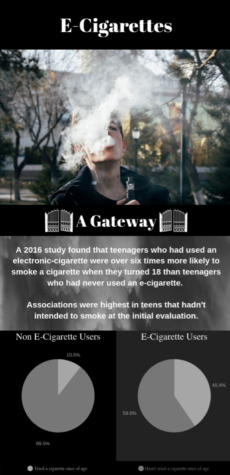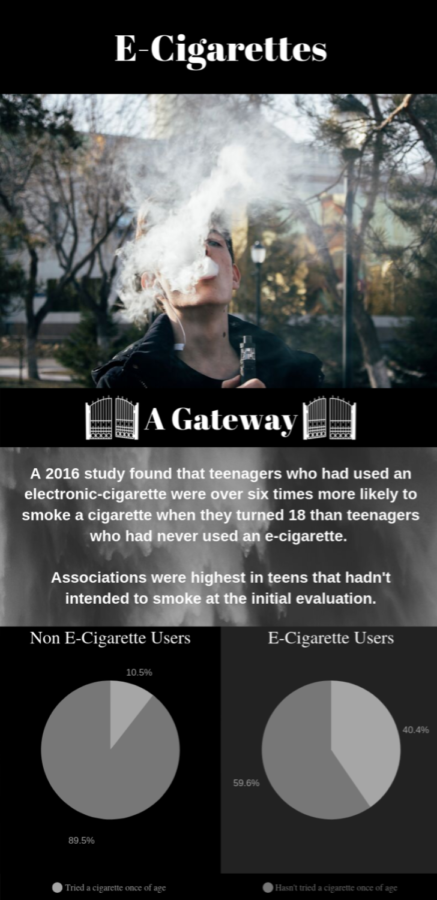E-Cigarettes: facts and fictions
Electronic cigarettes, known to most as e-cigarettes, are electronic devices that create aerosols that are inhaled. The aerosols are formed from an “e-liquid” that could contain nicotine and, a usually fruity like, flavor. The Food and Drug Administration classify e-cigarettes as electronic nicotine delivery systems, which are defined as non-combustible tobacco products. There are a lot of misunderstandings about e-cigarette use, and it is important to separate the facts from the fictions of e-cigarettes.
Health Effects
The long-term health effects of e-cigarette use are largely unknown, due to their novelty. The short-term health effects, in contrast, are at least somewhat known. While many make the claim that e-cigarettes are harmless, non-addictive and do not cause any respiratory illnesses, those claims are not supported by the evidence. According to a consensus report done by the National Academies of Sciences, Engineering, and Medicine, “There is conclusive evidence that in addition to nicotine, most e-cigarette products contain and emit numerous potentially toxic substances.” The academy also found that, “There is substantial evidence that e-cigarette use results in symptoms of dependence on e-cigarettes.” The report found that, “There is no available evidence whether or not e-cigarette use is associated with clinical cardiovascular outcomes”.
Another claim that is very commonly made is that the health effects of e-cigarettes are just as, if not more, harmful than traditional cigarette use. Due to the lack of knowledge of the long-term health effects of e-cigarette use, It is impossible to reasonably conclude that e-cigarettes are either more or less harmful than normal cigarettes, but the evidence indicates that the effects of e-cigarettes are less dangerous, at least in the short-term.
A Gateway
 ‘Gateway Drug’ is a term used to describe substances that, while not necessarily dangerous themselves, act as a gateway of sorts to using another substance that is more directly harmful. E-cigarettes are often depicted as a gateway drug to regular cigarettes. According to a 2016 study published in Pediatrics, “E-cigarette use in never-smoking youth may increase risk of subsequent initiation of cigarettes and other combustible products during the transition to adulthood when the purchase of tobacco products becomes legal.” The infographic on the right shows some of the data found in that study. The fact that associations were higher in teens who didn’t intend to smoke indicates that this is not just people who would have smoked anyway, regardless of e-cigarettes. The evidence does indicate that e-cigarette use could be considered a gateway drug for teenagers.
‘Gateway Drug’ is a term used to describe substances that, while not necessarily dangerous themselves, act as a gateway of sorts to using another substance that is more directly harmful. E-cigarettes are often depicted as a gateway drug to regular cigarettes. According to a 2016 study published in Pediatrics, “E-cigarette use in never-smoking youth may increase risk of subsequent initiation of cigarettes and other combustible products during the transition to adulthood when the purchase of tobacco products becomes legal.” The infographic on the right shows some of the data found in that study. The fact that associations were higher in teens who didn’t intend to smoke indicates that this is not just people who would have smoked anyway, regardless of e-cigarettes. The evidence does indicate that e-cigarette use could be considered a gateway drug for teenagers.
A Substitute
While e-cigarettes may be a gateway to smoking, they may also be a tool to quit smoking. According to the aforementioned consensus report,
“Overall, the evidence suggests that while e-cigarettes might cause youth who use them to transition to use of combustible tobacco products, they might also increase adult cessation of combustible tobacco cigarettes.”
Saying that e-cigarettes are either only harmful to people or only helpful for people is inaccurate and their use is a complex issue. Wherever you fall on the debate on e-cigarettes, it is important to be aware of what conclusions are supported by science, and which aren’t.
Your donation will support the student journalists of Richland Northeast High School. Your contribution will allow us to attend conferences, purchase equipment and cover our annual website hosting costs.






